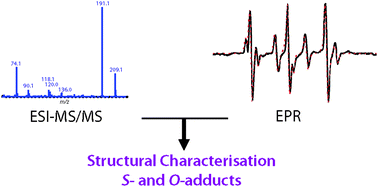Combining EPR and ESI-MS/MS to study the reactivity of alkylthiols and cysteine towards 2-methyl-2-nitrosopropane (MNP)
Abstract
An approach combining

a
Universités Aix-Marseille I, II & III—CNRS, UMR 6264, Laboratoire Chimie Provence, Spectrométries Appliquées à la Chimie Structurale, Campus Saint-Jérôme, Case 511, Marseille Cedex 20, France
E-mail:
laurence.charles@univ-provence.fr
Fax: +33 491282897
Tel: +33 491288678
An approach combining

 Please wait while we load your content...
Something went wrong. Try again?
Please wait while we load your content...
Something went wrong. Try again?
M. Triquigneaux, B. Tuccio and L. Charles*, Anal. Methods, 2010, 2, 694 DOI: 10.1039/C0AY00185F
To request permission to reproduce material from this article, please go to the Copyright Clearance Center request page.
If you are an author contributing to an RSC publication, you do not need to request permission provided correct acknowledgement is given.
If you are the author of this article, you do not need to request permission to reproduce figures and diagrams provided correct acknowledgement is given. If you want to reproduce the whole article in a third-party publication (excluding your thesis/dissertation for which permission is not required) please go to the Copyright Clearance Center request page.
Read more about how to correctly acknowledge RSC content.
 Fetching data from CrossRef.
Fetching data from CrossRef.
This may take some time to load.
Loading related content
